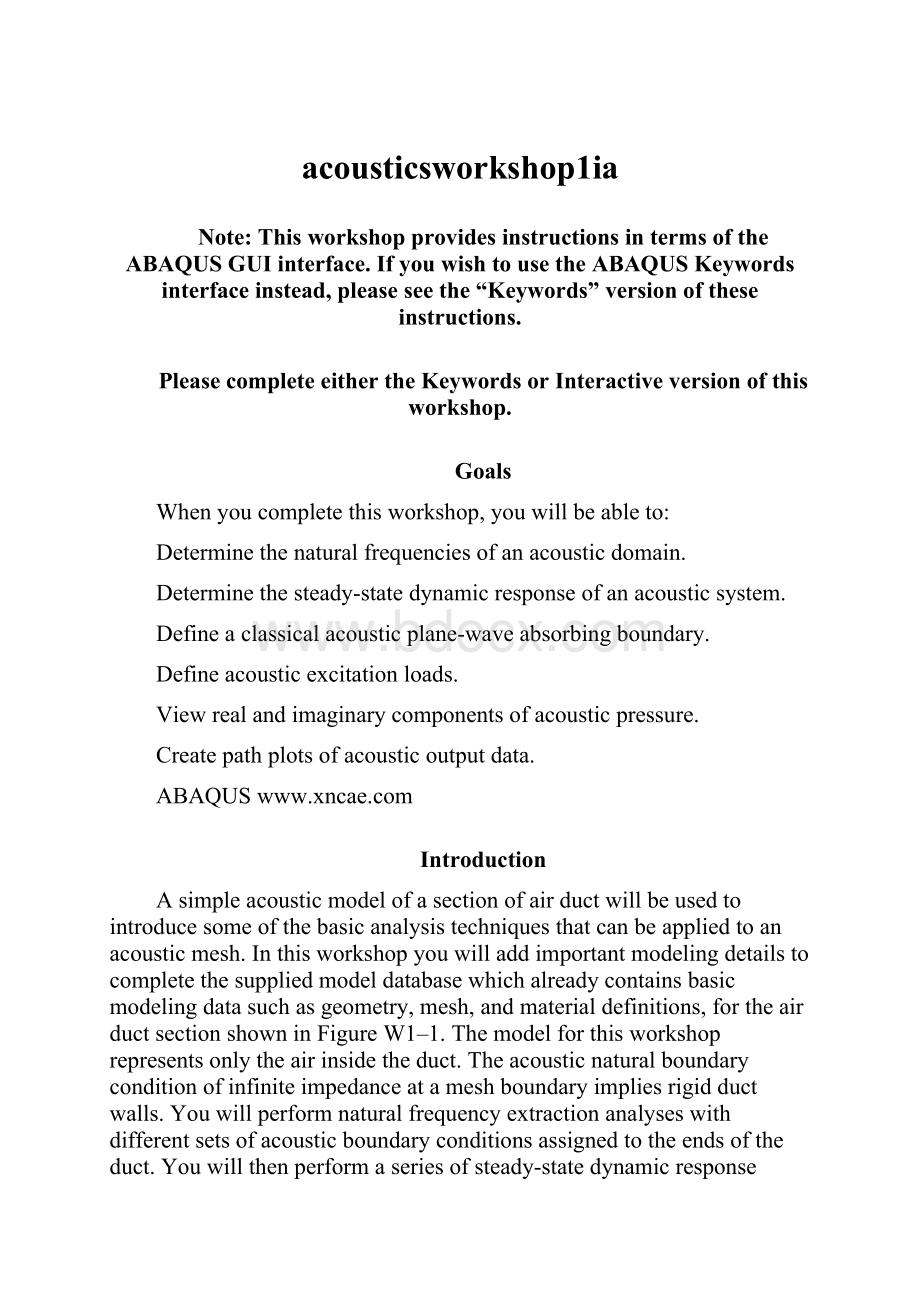acousticsworkshop1ia.docx
《acousticsworkshop1ia.docx》由会员分享,可在线阅读,更多相关《acousticsworkshop1ia.docx(19页珍藏版)》请在冰豆网上搜索。

acousticsworkshop1ia
Note:
ThisworkshopprovidesinstructionsintermsoftheABAQUSGUIinterface.IfyouwishtousetheABAQUSKeywordsinterfaceinstead,pleaseseethe“Keywords”versionoftheseinstructions.
PleasecompleteeithertheKeywordsorInteractiveversionofthisworkshop.
Goals
Whenyoucompletethisworkshop,youwillbeableto:
Determinethenaturalfrequenciesofanacousticdomain.
Determinethesteady-statedynamicresponseofanacousticsystem.
Defineaclassicalacousticplane-waveabsorbingboundary.
Defineacousticexcitationloads.
Viewrealandimaginarycomponentsofacousticpressure.
Createpathplotsofacousticoutputdata.
ABAQUS
Introduction
Asimpleacousticmodelofasectionofairductwillbeusedtointroducesomeofthebasicanalysistechniquesthatcanbeappliedtoanacousticmesh.Inthisworkshopyouwilladdimportantmodelingdetailstocompletethesuppliedmodeldatabasewhichalreadycontainsbasicmodelingdatasuchasgeometry,mesh,andmaterialdefinitions,fortheairductsectionshowninFigureW1–1.Themodelforthisworkshoprepresentsonlytheairinsidetheduct.Theacousticnaturalboundaryconditionofinfiniteimpedanceatameshboundaryimpliesrigidductwalls.Youwillperformnaturalfrequencyextractionanalyseswithdifferentsetsofacousticboundaryconditionsassignedtotheendsoftheduct.Youwillthenperformaseriesofsteady-statedynamicresponseanalysesonthemodelusingdifferentexcitationmethods.Thesteady-statedynamicanalyseswillalsoincludethedefinitionofacousticplane-waveabsorbingboundaryimpedanceatoneendoftheducttoinvestigatepostprocessingoftravelingwavesforfrequency-domainsolutions.
FigureW1–1Modelofasimpleairductsection.
Preliminaries
1.Entertheworkingdirectoryforthisworkshop:
../acoustics/interactive/workshop1
2.Runthescriptws_acoustic_duct.pyusingthefollowingcommand:
abaquscaestartup=ws_acoustic_duct.py
TheabovecommandcreatesanABAQUS/CAEdatabasenamedduct.caeinthecurrentdirectory.Thegeometry,materialandmeshdefinitionsfortheairductsectionmodelshowninFigureW1–1areincludedinthedatabase.Theairductsectionis4.25mlongandhasarectangularcross-sectionthatis0.2mby0.125m.Theacousticmediumisairwithadensityof1.225kg/m3andasoundspeedof340m/s.Thus,theeffectivebulkmodulusis141610Pa.Themodelisdesignedtoprovidereasonablequantitativeresultsforanalysesupto400Hzandutilizesfirst-orderacousticelementsthatare0.085mlong.Thismeshrefinementcorrespondsto10elements(nodaldivisions)peracousticwavelengthataresponsefrequencyof400Hz.Thelargestcross-sectionaldimensionoftheductissignificantlylessthanone-halfthe400Hzacousticwavelength;therefore,theductcross-sectioncanbemodeledwithasingleelement.Thesegeometric,material,andmeshpropertiesshouldnotbemodifiedforthisworkshop.However,aftercompletionofthisworkshopyoumaywanttoconsidermodifyingthemeshtoperformadditionalconvergenceandaccuracystudies.
Note:
Ingeneral,second-orderacousticelementsaremoreaccuratethanfirst-orderacousticelementsforthesamemeshnodaldensity.However,first-orderelementscanprovidenearlyasgoodanapproximationtoasinusoidalacousticpressurewaveascansecond-orderelementsaslongasthenodaldistributionsaresimilar.Therefore,whenperformingacousticanalysesinwhichdeterminingthepressurefieldisofprimaryinterest,first-orderelementsareoftenusedbecausetheycanbeeasiertoworkwith.Themainadvantageofsecond-orderacousticelementsisthattheyprovideforapiecewiselinearapproximationofthepressuregradients(and,thus,theparticlevelocities),whilethefirst-orderelementsproduceapiecewiseconstantapproximation.Therefore,formesheswithsimilarnodaldensities,thesecond-orderelementswillprovidesignificantlybetterquantitativeresultsforitemssuchasacousticintensity(power)thatrequireaccurateestimatesofpressuregradientsandparticlevelocities.Usingfirst-orderacousticelementstodetermineapressurefieldisanalogoustousingfirst-orderstress-displacementelementstodeterminestiffness,whileusingsecond-orderacousticelementstodetermineacousticintensityisanalogoustousingsecond-orderstress-displacementelementstodetermineastress/strainconcentration.
Case1:
Naturalfrequencyextraction(rigid-rigidends)
ThefirstanalysisforWorkshop1involvesextractingthenaturalfrequenciesoftheairductsectionshowninFigureW1–1forthecasewherebothendsoftheductutilizethenaturalboundaryconditionassociatedwithanacousticmesh.Therefore,forthiscasenoboundaryconditionsorloadingoptionsareappliedtotheacousticpressuredegreeoffreedom.Thenaturalboundaryconditionassociatedwiththesurfaceofanacousticmeshcorrespondstoinfiniteboundaryimpedance.Themeshboundarycanthereforebeenvisionedasaninfinitelyrigidsurface.
3.InanABAQUS/CAEsession,openthedatabasenamedduct.cae,whichwascreatedbyrunningthesetupscript.
4.Createanaturalfrequencyextractionsteptoobtainupto25naturalfrequenciesintherangefrom5Hzto400 Hzwithashiftpointcorrespondingto100Hz.Detailedinstructionsareprovidedbelow.UseofthedefaultLanczoseigensolverisrecommended.Theextractionofnaturalfrequenciesforanacousticmeshinrealworldproblemswilllikelyinvolverelativelylargemodels,forwhichtheLanczoseigensolverismoreefficientthanthesubspaceiterationeigensolver.Inaddition,theLanczoseigensolverallowsyoutoselectaprecisefrequencyrangefortheeigenvalueextraction.
a.IntheModelTree,double-clicktheStepscontainer.
b.IntheCreateStepdialogbox,choosetheLinearperturbationproceduretypeandselectFrequencyfromthelistofavailableprocedureoptions.Acceptthedefaultstepname,Step-1.
c.ClickContinue.
d.IntheEditstepdialogbox,specify25astherequestednumberofeigenvalues.Enter10000asthefrequencyshiftinsquaredcyclespertime.Specify5and400astheminimumandmaximumfrequenciesofinterest,respectively.Enteranappropriatestepdescription.AccepttheLanczoseigensolverandotherdefaultstepsettings.
e.ClickOK.
5.IntheModelTree,clickmousebutton3(MB3)onthejobnamedduct-1andselectSubmitinthemenuthatappearstosubmitthejobforanalysis.
6.Aftertheanalysiscompletes,useatexteditortoreviewtheprintedoutputfileduct-1.dat.ComparethenaturalfrequencieslistedintheEigenvalueOutputtabletotheexactclassicalvaluesforthisproblem.Theclassicalsolutionisforafundamentalmodeof40Hzwithanintervalof40Hzbetweensuccessivemodes.
7.IntheModelTree,clickMB3onthejobnamedduct-1andselectResultsinthemenuthatappears.ABAQUS/CAEloadstheVisualizationmoduleandopensthefileduct-1.odb.
8.ViewtheacousticmodeshapesbycreatingcontourplotsofthepressurevariablePOR(PlotContours).
9.DefineapathalongthelengthoftheductsectionandcreateaplotofPORalongthispathusingtheprocedurebelow.
a.Fromthemainmenubar,selectToolsPathCreate.
b.IntheCreatePathdialogbox,acceptthedefaultpathname(Path-1)andtype(Nodelist).ClickContinue.
c.IntheEditNodeListPathdialogbox,clickAddBefore.
d.Intheviewport,selectthestartandendpointsforthepath,asshowninFigureW1–2.ClickDoneinthepromptarea.
e.ThetableintheEditNodeListPathdialogboxnowcontainstheselectednodelabels.ClickOKtocompletethepathdefinition.
f.Fromthemainmenubar,selectToolsXYDataCreate.
g.IntheCreateXYDatadialogbox,choosePathandclickContinue.
h.IntheXYDatafromPathdialogbox,toggleonIncludeintersectionstoobtainX–Ydataatlocationswherethepathintersectsthemodelaswellasatthepointsthatmakeupthepath.
i.IntheYValuesportionoftheXYDatafromPathdialogbox,clickStep/Frame.IntheStep/Framedialogboxthatappears,choosethemodeofinterestandclickOK.
j.IntheCreateXYDatadialogbox,clickPlottogeneratethepathplot.
FigureW1–2containsexamplesofbothacontourandapathplotforthefifthmode.
FigureW1–2Fifthacousticmodeshapeofthe
airductsectionwithrigid-rigidends.
CASE2:
Naturalfrequencyextraction(rigid-freeends)
Asstatedearlier,thenaturalboundaryconditionassociatedwiththesurfaceofanacousticmeshcorrespondstoinfiniteboundaryimpedance.Thisimpliesthattheacousticparticlevelocitynormaltotheboundarysurfaceiszero.Theboundarysurfacecan,therefore,bethoughtofasrigid.Thenaturalboundaryconditionischaracterizedbyazeropressuregradient,asillustratedintheCase1analysisbythepathplotshowninFigureW1–2.Assigningavaluetotheacousticpressuredegreeoffreedomataboundingsurfacerepresentsakinematicboundaryconditionandcorrespondstozeroboundaryimpedance.Thistypeofboundaryconditionallowsacousticparticlestomovefreelyacrosstheboundingsurface.Theacousticparticlevelocityattheboundingsurface,characterizedbythepressuregradient,isthenunknowninamanneranalogoustoareactionforceinstructuralmechanics.Forthisanalysiscaseyouwilldeterminethenaturalfrequenciesoftheairductsectioninwhichoneendhasinfiniteboundaryimpedance(rigid)andtheotherhaszeroboundaryimpedance(free).
1.Copythemodelduct-1toamodelnamedduct-2.
a.IntheModelTree,clickMB3onthemodelnamedduct-1andselectCopyModelinthemenuthatappears.
b.Enterduct-2asthenameofthenewmodel.
Allinstructionsthatfollowapplytothemodelnamedduc